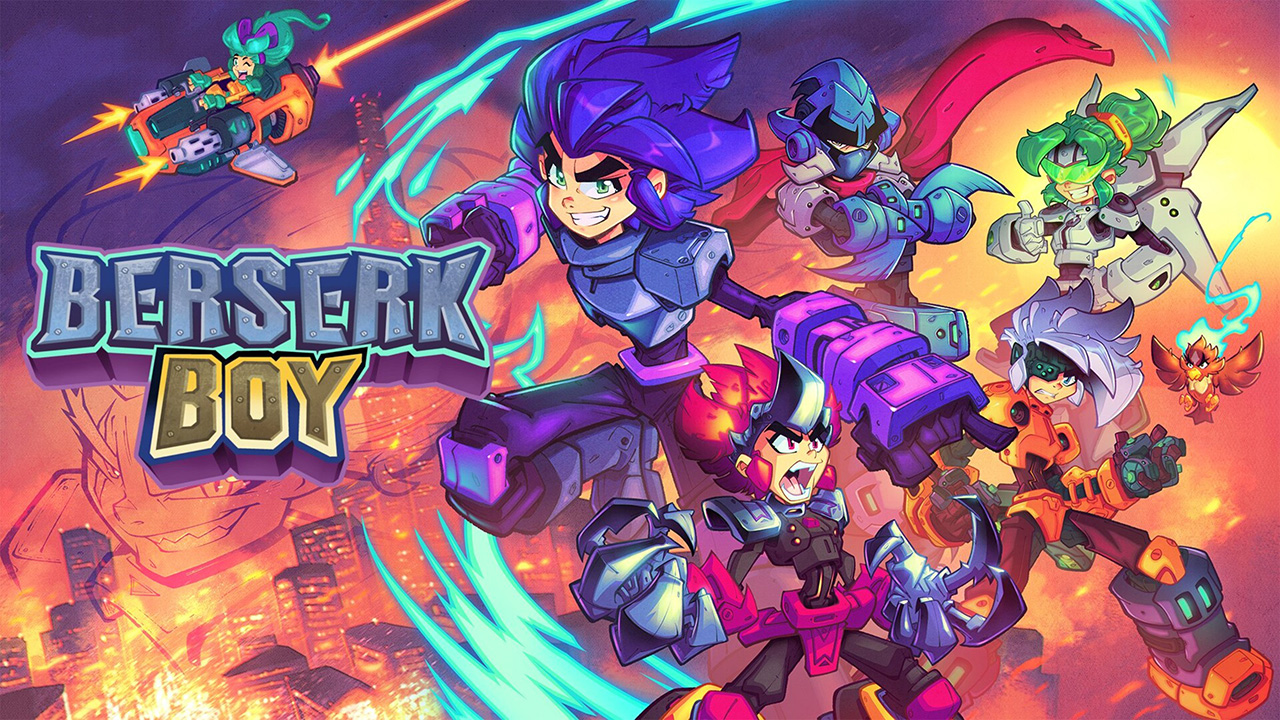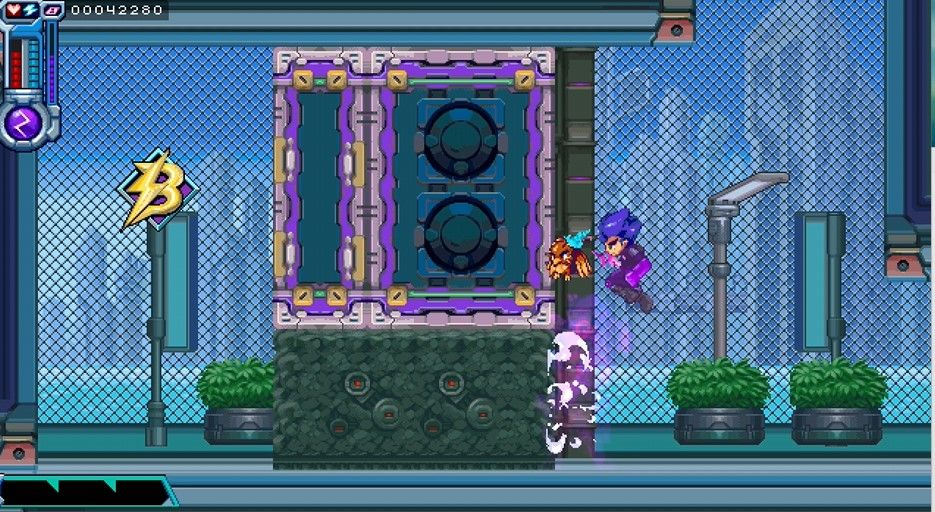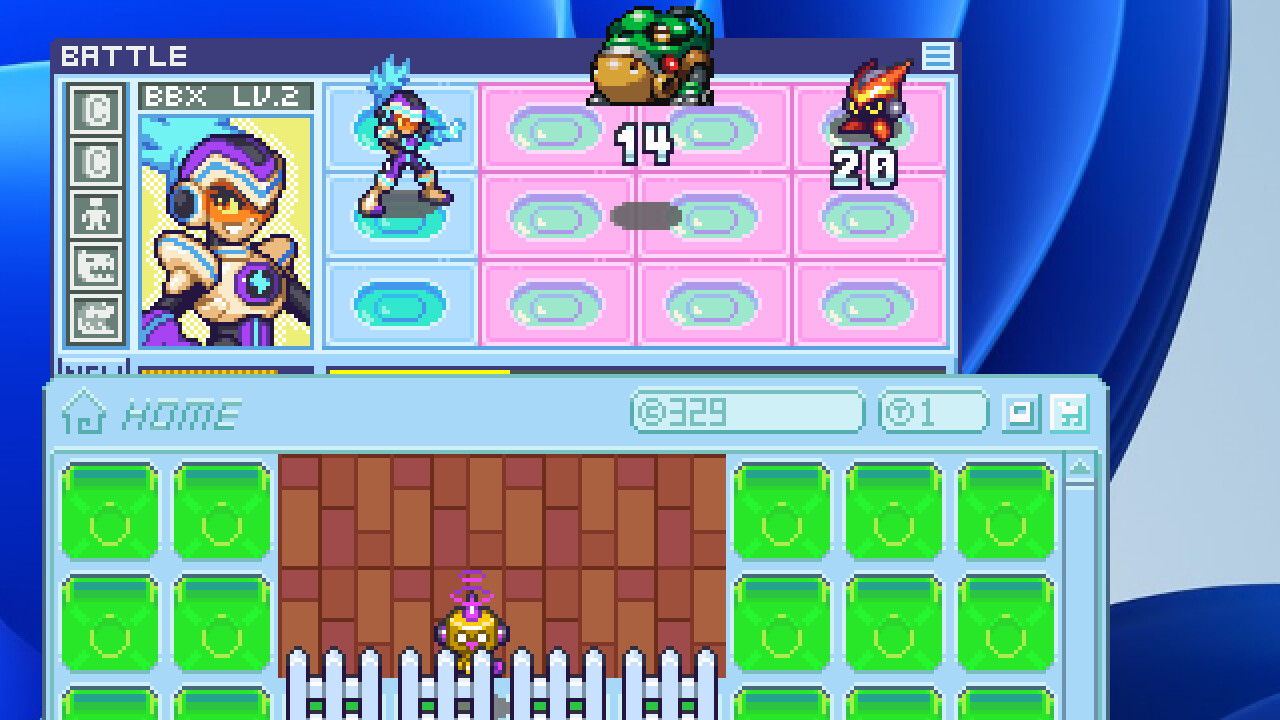Berserk Boy review: Hey, wait a minute...

Berserk Boy, released earlier this year, is a game I enjoyed moment to moment, but I wish I enjoyed it more. As it stands, it's overall a pretty good game that I hope did well enough to warrant a sequel to refine its ideas further, but it isn’t quite a must-play. It did, however, drive me a little insane for one specific reason, which is why when I sat down to write a review for my Backloggd account it turned into all this.
Here’s the thing: I love Mega Man ZX and Mega Man ZX Advent, the tokusatsu-flavored, Metroidvania-ish successors to Mega Man Zero released on the DS in the '00s. They’re some of my favorite Mega Man games, and I'm perpetually sad that Capcom never let Inti Creates make a third ZX game to follow up on Advent’s post-credits stinger. So it was a pleasant surprise when I started Berserk Boy and realized it wasn't just “Mega Man-inspired,” as it’s generally been called by the press in various positive-to-glowing reviews, but specifically Mega Man ZX-inspired. The ZX influence and the banger soundtrack by living legend Tee Lopes should be more than enough to make me love this game.
However, there's a difference between homage and unoriginality, and you couldn’t make a more blatant “homage” to the original Mega Man ZX without getting a strongly-worded letter from Capcom. I’ve played and loved a ton of indie spiritual successors to older games before, platformers especially, but I’m genuinely not sure I’ve ever seen one replicate the details of one specific game so closely with so few new embellishments or twists before. It doesn’t feel like a game inspired by Mega Man ZX, or even like a fan-made ZX 3 in all but name, so much as it feels like a romhack remix of ZX 1 that tweaks a few of the player character's forms and gives it different level design. And in some ways you could definitely argue it improves on its inspiration, but it’s harder for me to appreciate that when the game seems to actively deny giving itself its own identity.
A Biometal by any other name
So much of this game is just lifted straight from ZX. The paper-thin plot is basically just an abridged version of ZX’s. It opens with our teenage hero Kei, briefly playable only in his powerless civilian form, having a conversation in a forest area on the outskirts of his futuristic home city. Soon after, a sudden attack from the villain leads to a chance encounter where he’s bestowed an artifact that lets him transform tokusatsu-style into a superpowered hero form. Then he goes around beating other bosses with similar powers and earning four more element-themed transformations, with which he’ll aid a heroic resistance group that’s fighting against a villain who’s trying to harness some kind of “dark energy.” One of those transformations is green, puts wings on the hero’s head, and lets him fly, which is kind of overpowered for a lot of platforming sections. Another one turns him into a red-scarfed ninja, letting him hang from wires and throw rapid-fire kunai (either in a straight line while on the ground or in a sweeping downward arc while jumping). The sense of deja vu is overwhelming.


Even most of the level motifs are direct recreations of those from ZX. The first level has some nods to some Mega Man X series opening stages, but it’s absolutely a parallel to the central city area in ZX. The forest stage and its twisty, mossy, cybernetic trees look almost identical to ZX's opening stage. A late game level evokes the lit-up dusk cityscape of ZX's highway areas. The airship fleet is probably a reference to the airship that serves as the home base in ZX, if not Ashe’s opening airship fleet stage from ZX Advent. That game gets a bit of Berserk Boy’s attention, too, to a lesser extent. The lock on targeting of the fifth form is clearly based on the gameplay of Model A, the main form in ZX Advent, and the final stages echo the aesthetics of both ZX Advent’s floating ruins area and Ouroboros, its final stage. Only the ice stage really stands out at all as notably different from the ZX games' ice levels by throwing some torii gates and other Japanese architecture in for spice, though for fans of Tee Lopes this will probably just evoke memories of Press Garden Zone Act 2.
When it's not referencing Mega Man ZX, it's usually just referencing another game Inti Creates made in that same lineage. The needlessly huge and empty Resistance base area you return to between missions is modeled blatantly after the two Resistance bases from the Mega Man Zero series. The combat definitely feels different from ZX, with your main form being built around air dashing into enemies to tag them and then hitting them with homing lightning. The focus on dashing into enemies may evoke memories of Mighty No. 9, but really this is just the playstyle of Copen from the Gunvolt series (Inti’s own spiritual successor to Mega Man Zero and ZX) and its spinoff, Luminous Avenger iX, mixed with the lightning theming of Gunvolt himself. Even the addition of a combo counter is something from Gunvolt. It’s Inti all the way down.


It drives me kind of insane that this isn’t a more common talking point around the game. Players have certainly noticed it, but many professional reviews will neglect to mention Mega Man ZX at all. They’ll call it a broad throwback to the 16-bit era, or try to compare it to “Mega Man meets Sonic” because the gameplay is fairly fast and the fire form evokes the Drill Wisp. But like, no! It’s none of those things! It doesn’t have Sonic’s momentum or loop-de-loops. It just wants to be a remix of one very specific cult classic Mega Man game for the Nintendo DS! These similarities just aren’t something everyone will notice because the ZX and Gunvolt games are less well known than classic Mega Man or Mega Man X. Reviews will say it doesn’t feel like a straight retread because they haven’t played the somewhat obscure games it’s retreading. But I HAVE played Mega Man ZX so this was practically the only thing I could think about throughout the game. It’s SO in-your-face about it if you know the references. It's not just trying to evoke the general vibe of its inspiration. The gameplay, the story, a majority of the forms, the specific aesthetics of the levels, it's all agonizingly similar in a way I've never seen before.
Going Berserk
But, okay. Where does this leave Berserk Boy as its own game, then? How much of its own identity does it have? It can't LITERALLY be the same game. Well, the major difference is that rather than being a Metroidvania with confusing level connections like Mega Man ZX, or even having a traditional Mega Man stage select, it features a linear progression of stages. There are five worlds with three levels each (plus unlockable bonus stages), and you acquire new transformations in a predetermined order. The tradeoff for this lack of choice is that levels can be built to require frequent use of all of the transformations you've unlocked up to that point, something the nonlinear structure of ZX couldn’t accommodate. A level might make you hang from wires with the ice ninja form, then zip across a gap with the default lightning form, then burrow through the ground with the fire drill form, all in rapid succession. You generally can’t just rely on your favorite form, the level design requires you to use ALL of the tools at your disposal. This often makes the platforming in Berserk Boy a lot of fun, and it’s the main thing keeping it from just being a 1:1 copy of ZX. Again, I said I mostly enjoyed this game moment-to-moment, and this is why.
Really, the satisfying platforming is only let down by how repetitive it is. (And the fact that the flying form eventually trivializes most of it.) Most levels use the same set of obstacles over and over, only introducing a few new ones at the start of every world to take advantage of your latest transformation. You’ll be chased by spike blocks, burrow through large patches of dirt with the fire drill, blast through chains of Donkey Kong Country-style cannons, and have to open locked doors by zapping a nearby button so very many times. Each world has very little identity beyond its music and what level aesthetic it’s chosen to lift from the ZX games this time, and the three levels within each world tend to blend together, too. The combat, while flashy and fun, also ends up feeling fairly repetitive. There aren’t all that many enemy types, and the tag-and-zap combo of the default transformation is so powerful that I rarely felt the need to fight with anything else, aside from a couple boss fights where the range of the ice form's kunai felt like an advantage.

While the game’s structure is more linear, though, that doesn’t mean it’s free from backtracking. Every level contains a handful of collectibles that can only be obtained with a form you won’t have yet on your first visit. This is where we get to the game’s most glaring flaw.
After defeating what seems to be an anticlimactically easy final boss, the villain will flee and the game will dump you back into the Resistance base. If you ask around a little, you’ll find that in order to really beat the game you need to find 50 of the medals hidden in each stage. I had collected 30 of them by that point. I wouldn’t be surprised if a lot of players had less than that after completing the fifth world, since the game had never explained why the medals would be important to collect before this point. And since many of those medals are only obtainable when you replay earlier levels with additional forms unlocked, this effectively means the game asks you to play through it twice. The levels do let you teleport from checkpoint to checkpoint, which should theoretically help with all this backtracking… but there’s no in-game map to tell you which parts of each level you have yet to fully explore, and also the checkpoints are all reset when you come back to a stage, meaning you really do just have to play through the whole thing again. Yes, they really took Gunvolt hiding its true ending behind finding a bunch of collectibles and made it even worse.
Hopefully it isn’t surprising to hear that this is the point where I decided I’d had enough and shelved Berserk Boy.
Conclusion
I could nitpick more. I could complain about the repetitive voice lines. I could complain about how superfluous the upgrade shop feels, or the fact that the health and energy bars don’t visibly change when you upgrade your max health and energy. I could complain about the fact that the only boss that gets anything you could call “characterization” is just one big joke about how annoying Flame Hyenard was in Mega Man X7. But really, after that anticlimactic non-ending, the only thing I’m probably going to remember about this game, aside from its soundtrack, is how uncannily similar it was to Mega Man ZX and Gunvolt, and how much that bugs me.
I don’t say this to go after the dev for “plagiarism” or whatever. Other games shamelessly rip off their inspirations all the time. Mega Man himself is a shameless ripoff of Astro Boy. I’m not here to play Copyright Cop for Capcom. The devs of Berserk Boy are allowed to do this. But, like… why would you do this? Why remake a game that already exists? Why not take your love of that game and expand on it, instead of just treading the exact ground your inspiration already walked? There are so many ways you could riff on the gameplay of Mega Man ZX in a more original package! You could just swap out the sci-fi theme for fantasy, or make it a different flavor of sci-fi by setting it in space or something. You could take the tokusatsu influence and crank it up to 11. You could give the player more unique and creative forms. But at almost every point, when given an opportunity to do something new or different, Berserk Boy chooses to do things in the way that will most remind you of ZX. Indie spiritual successors are rarely subtle about their inspirations, but they're usually not this direct about it. There's so little desire to explore beyond the possibilities presented by ZX.
It’s like if Freedom Planet had ditched its Chinese science fantasy vibe and instead starred an indigo porcupine who travels through levels like Checkerboard Hill Zone, Granite Zone, and Bounce Yard Zone on a quest to defeat Professor Roundguy. It’s like if the team behind Bug Fables had decided not to take the gameplay of Paper Mario and iterate on it with their own insect-themed premise and characters and world, and instead made a Paper Mario-inspired RPG that starred a hammer-wielding plumber whose adventure sent him through a shady port town, a flowery meadow overlooked by a dragon’s castle, a monochrome forest, and on and on and on. Is this what we want? Because it’s not what I want. There's fans taking matters into their own hands to make a new game in a dead series, and then there's fans just making the same game again. Berserk Boy mostly chose the latter, and it feels like a wasted opportunity.
So, ironically, despite being intended as a love letter to the ZX games, I think Berserk Boy will land best for people who haven’t played them. It’s by no means a terrible or unfun game, it’s just a game that makes me wish I was playing one of my middle school favorites instead. It’ll feel fresher for people without that problem. Which is why it's gotten glowing reviews praising it for its originality from reviewers who make zero mention of its primary inspiration.
That said, it does seem like it’s a game struggling to find its audience, even with a name like Tee Lopes attached. Even with all my griping, I do think this is a shame. It’s probably partially plain old bad luck and poor timing. It came out two weeks after Penny’s Big Breakaway, which also featured music by Tee Lopes, and a week after FF7 Rebirth. But it might also come down to the presentation. The game certainly doesn’t look bad, with really nice backgrounds and flashy effects, but the faux-anime character designs are painfully generic and unexciting. They look like the designs from a fake anime or video game a fictional kid would be into in an American TV show, and the extremely halfhearted writing and worldbuilding do nothing to make me more attached to them. And that name… I’m sorry, but “Berserk Boy” is a terrible title. (And calling the macguffins that let you transform “Berserk Orbs” is even worse.) It’s just a game that’s easy to dismiss at a glance. It has no idea how to give itself its own identity when it's not just borrowing things from ZX or Gunvolt.
I just hope it’s done well enough for the team to take another shot at it with a sequel, hopefully stepping out of Inti Create’s shadow in the process, because this really could be the rough draft for something special. A ton of talent and effort went into this, and they really could make something great that evokes what I love about Mega Man ZX without just feeling like a romhack that gives it a linear campaign. But then their recently announced next game (Berserk B.I.T.S) is a Mega Man Battle Network-inspired desktop buddy idle game with a main character that’s practically just a recolor of Star Force Mega Man, which doesn’t inspire the most confidence. Please, you guys could knock it out of the park so hard if you’d just take your love of Mega Man and make something 10% more original with it! I’m begging you!!!


Comments